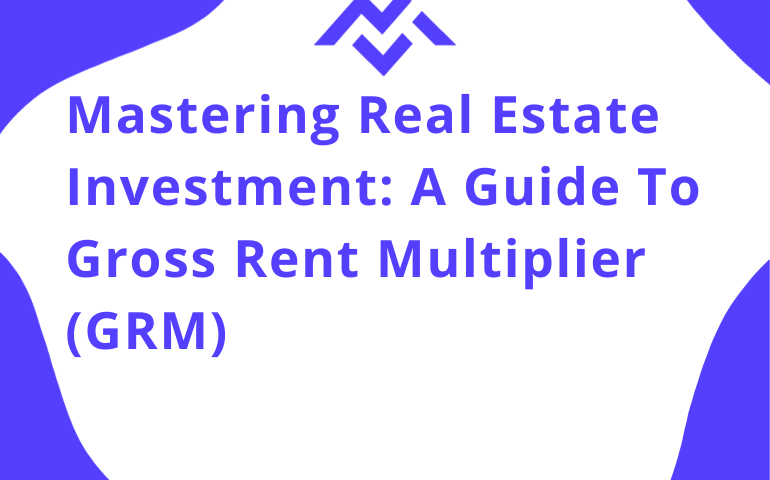
Mortgage Dove
Mastering Real Estate Investment: A Guide To Gross Rent Multiplier (GRM)
Thinking about purchasing an investment property involves a bunch of things to consider. There's choosing the right neighborhood, checking out the schools nearby for potential renters, looking into rental vacancies, and more. Oh, and you can't forget about comparing different investment property portfolios. One crucial thing you shouldn't overlook is the gross rent multiplier! Haven't come across the term "gross rent multiplier" before? No worries! Let us explain why it's essential to include this handy tool on your checklist for investment properties. The gross rent multiplier (GRM) is a simple way to determine how profitable properties in a particular market might be by considering their yearly rental income. The GRM formula is a helpful financial tool, especially when rental prices in the market are changing quickly, just like they are nowadays. Consider GRM as comparing properties in terms of what they currently make from rent and what they could earn if their rents align with the market rates. This comparison is similar to evaluating fair market values based on rental incomes. Let's check out the gross rent multiplier formula. It tells you how to figure out the GRM for a rental property: GRM = Fair Market Value ÷ Gross Rental Income For instance, if the Fair Market Value is $200,000 and the Gross Rental Income is $24,000, the GRM would be 8.3. This formula compares a property's value to its rental income. In the example, it shows the payoff time to be a bit over 8 years. This calculation excludes other costs like repairs, vacancy rate, taxes, and insurance. Still, GRM is just one tool to help decide between similar properties without considering these extra expenses. A decent GRM hinges on the rental market where your property is located. Aiming for a GRM falling between 4 and 7 is considered good. A lower GRM indicates a faster payoff for your rental property. Nevertheless, the ideal GRM can vary based on the specific real estate market you're dealing with. For instance, a GRM of 7.5 might not appear excessively high for a particular investment property, depending on the market conditions. GRM and capitalization rates are often compared alongside net operating income (NOI) in real estate evaluations. The capitalization rate (also known as the real estate cap rate) assesses the return on commercial real estate by dividing the property’s net operating income (NOI) by its asset value. NOI calculates the revenue and profitability left after deducting operational expenses. These metrics hold significance in property assessment. However, GRM is a quicker and more efficient way to evaluate investment properties than cap rate or NOI. It provides a swifter analysis for potential investments. There are some upsides and downsides when using the gross rent multiplier: Pros GRM presents an easy and speedy method for comparing similar properties within a market, aiding investors in making quicker and more informed decisions. It offers a straightforward formula suitable for new rental property investors, allowing them to estimate property values easily. As a simple tool, it helps identify real estate investment opportunities that hold the most promise within a given market. GRM focuses on the income generated through rent, providing a distinct perspective that doesn't rely on traditional metrics like property price or unit-specific pricing. Both parties can employ GRM to evaluate rental properties. For example, sellers with well-maintained properties may set higher prices and lower GRMs, while buyers seeking bargains look for lower GRMs, indicating potential below-market prices or higher rental incomes. Cons GRM's limitation lies in its failure to account for operating expenses, potentially misrepresenting a property's profitability to investors. Properties with low GRMs may seem attractive but could entail significant costs due to deferred maintenance, which the formula overlooks. GRM fails to consider the impact of vacancies due to tenant turnover or extended rental voids from poorly maintained properties, affecting income projections. Some investors mistakenly interpret GRM as a measure of the time needed to pay for a property. However, it only compares gross rental income to property value, offering a limited view of investment potential. Let's see how GRM can be used effectively. First, calculate your GRM using the given formula. Once you have it, compare it with GRMs of similar properties. For instance, if a property you're eyeing has a GRM of 6 while others around it have GRMs of 8 or 10, choosing the one with a GRM of 6 might mean a better chance for profit. GRM can also help estimate property values in a specific market. If you know the GRMs of other properties in the area, you can gauge the fair market value of a property. For example, the average GRM of nearby properties is 6, and they make about $25,000 in cash flow yearly. In that case, you can estimate a property's worth using this formula: $25,000 × 6 = $150,000. Another use of GRM is to calculate gross rental income. For instance, if a property is valued at $150,000 and the average GRM in the area is 6, you can find the expected rental income by dividing the value by the GRM: $150,000 ÷ 6 = $25,000. By using these formulas, you can make your evaluation scale for assessing investment properties in a specific market. This method helps you become more informed about the key metrics to consider before purchasing. In simple terms, the GRM helps real estate investors decide. Lenders care a lot about a property's income and profitability, using GRM as a critical factor for lending. The 1% rule is another tool for making decisions. Together with GRM, it helps determine if a property is worth investing in. Property condition, repair costs, expenses, and cap rate also matter when deciding if a property can make money. GRM isn't the only answer for investing or not, but it's a good place to begin.What is the Gross Rent Multiplier (GRM)?
How to Calculate GRM Using a Simple Formula
What's a Decent Gross Rent Multiplier?
The Difference Between GRM and Capitalization Rates
The Pros and Cons of GRM
Using GRM in Real Estate Investments
The Bottom Line
"Mortgage Dove makes home financing convenient for every American. You can count on us to provide a home buying experience tailored to your personal needs and financial situation. We strive to give you the peace of mind that your home financing goals can be achieved.”

Mortgage®
www.mortgagedove.com



-and-how-does-it-work.png)